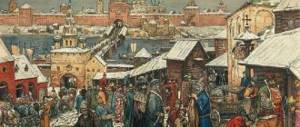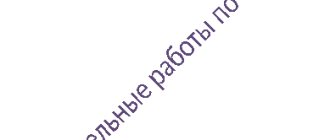Training on the topic: “Ancient Russian state”
1. In what century, according to the chronicle legend, were the Varangians called to rule in Novgorod?
1) VII century; 2) VIII century; 3) IX century. 4) X century.
2. In what century was Yaroslav’s Truth compiled? 1) VIII century; 2) IX century; 3) X century; 4) XI century.
3. In what year did the baptism of Rus' take place? 1) 882; 2) 988; 3) 1097; 4) 1147
4. In what century did Vladimir Monomakh reign in Kyiv? 1) IX century; 2) X century; 3) XII century; 4) XIII century.
5. In what year did the congress of princes take place in Lyubech? 1) 882; 2) 988; 3) 1097; 4) 1185
6. What was the name of the collection of tribute by the prince in Rus' in the 10th century? 1) tithe; 2) polyudye; 3) vira; 4) rope.
7. What was the name of the code of laws of the Russian state, adopted in the 12th century?
1) Russian Truth; 2) Cathedral Code; 3) Domostroy; 4) letter of complaint.
8. The consequence of the foreign policy activities of Prince Vladimir Svyatoslavich was:
1) cessation of military campaigns against Byzantium; 2) weakening the danger of Polovtsian raids; 3) strengthening the southeastern borders of the Old Russian state; 4) stopping the onslaught of the crusaders on the northwestern Russian lands.
9. Which of the above was one of the consequences of the baptism of Rus'?
1) Rus'’s campaigns against Byzantium; 2) strengthening the power of the Kyiv prince; 3) the beginning of military clashes between Rus' and the Pechenegs; 4) defeat of the Khazar Kaganate.
10. Read an excerpt from “The Tale of Bygone Years” and indicate the century to which the events described in the chronicle relate.
“And they went overseas to the Varangians, to Rus'. Those Varangians were called Rus, just as others are called Swedes, and others are called Normans and Angles, and still others are called Gotlanders, and so are these. The Chud, the Slovenians, the Krivichi and all said to the Russians: “Our land is great and abundant, but there is no order in it. Come reign and rule over us." And three brothers were chosen with their clans, and they took all of Rus' with them, and they came and the eldest, Rurik, sat in Novgorod, and the other, Sineus, in Beloozero, and the third, Truvor, in Izborsk.”
1) VIII century; 2) IX century; 3) X century; 4) XI century.
11. Read an excerpt from the chronicle and indicate the prince whose military campaign is being discussed.
“And with all these he went... on horses and in ships, and there were 2000 ships. And he came to Constantinople: the Greeks closed the city. And he went... ashore, and began to fight, and committed many murders to the Greeks in the vicinity of the city, and broke many chambers, and burned churches. ...And he ordered his soldiers to make wheels and put ships on wheels. And when a fair wind blew, they raised sails in the field and went to the city. The Greeks, seeing this, were frightened and said: “Do not destroy the city, we will give you the tribute you want.”
1) Oleg the Prophet; 2) Svyatoslav Igorevich; 3) Yaroslav the Wise; 4) Vladimir Svyatoslavich.
12. Read an excerpt from the chronicle and indicate the ancient Russian prince to whom the following words were addressed.
“And they sent with the words: “You, prince, are looking for someone else’s land and taking care of it, but you left your own, and the Pechenegs, and your mother, and your children almost took us. Don’t you feel sorry for your homeland, your old mother, your children?”
1) Oleg the Prophet; 2) Igor Stary; 3) Svyatoslav Igorevich; 4) Vladimir the Holy.
13.Indicate the name of the Kyiv prince of the 10th century, whose troops defeated the Khazar Kaganate.
1) Oleg; 2) Igor; 3) Svyatoslav; 4) Vladimir.
14. Indicate the prince whose activities include the compilation of the Russian Pravda code of laws.
1) Igor Stary; 2) Svyatoslav Igorevich; 3) Vladimir Svyatoslavich; 4) Yaroslav the Wise.
15. Which of the following relates to the activities of Prince Vladimir Monomakh?
1) adoption of Christianity by Russia; 2) introduction of lessons and graveyards; 3) defeat of the Khazar Kaganate; 4) congress of princes in Lyubech.
16. Which of the following relates to the activities of Princess Olga?
1) adoption of Christianity by Russia; 2) introduction of lessons and graveyards; 3) defeat of the Khazar Kaganate; 4) congress of princes in Lyubech.
17. Which of the following relates to the activities of Prince Vladimir Svyatoslavich?
1) adoption of Christianity by Russia; 2) introduction of lessons and graveyards; 3) defeat of the Khazar Kaganate; 4) congress of princes in Lyubech.
18. Indicate a monument of ancient Russian literature, the author of which is the monk of the Kiev-Pechersk Monastery Nestor.
1) “The Word on Law and Grace”; 2) “Teaching to children”; 3) “The Tale of Bygone Years”; 4) “The Tale of Igor’s Campaign.”
19. To the architectural monuments of Ancient Rus' of the 9th–11th centuries. refers to: 1) St. Basil's Cathedral in Moscow; 2) the Church of St. Sophia in Novgorod; 3) Church of the Ascension in the village of Kolomenskoye; 4) Trinity-Sergius Monastery.
20. Place the following events in chronological order. Provide your answer as a sequence of numbers for the selected elements:
1) unification of Kyiv and Novgorod under the rule of Prince Oleg
2) Danube campaigns of Prince Svyatoslav Igorevich
3) calling to rule the Varangians
4) introduction of lessons and graveyards
21. Arrange the following documents in the chronological order of their creation. Provide your answer as a sequence of numbers for the selected elements:
1) Cathedral Code; 2) Truth of Yaroslav; 3) Code of Law of Ivan III; 4) Charter of Vladimir Monomakh.
22. Indicate the categories of the dependent population of the Old Russian state, which included people who agreed to work under certain conditions, but whose dependent position did not extend to members of their families and was not inherited. Find two categories in the list below and write down the numbers under which they are indicated.
1) boyars; 2) artisans; 3) ordinary people; 4) merchants; 5) procurement
23.Write down the concept in question.
“Poetic tales of the past, in which the exploits of Russian heroes were glorified.”
24. Write down the term in question.
“The name of the East Slavic tribal union, located on the middle reaches of the Dnieper, the tribal center of which was Kyiv.”
25. Indicate the name of the process of settlement of the Slavs that is missing in the passage. Name the belief (religion) characteristic of the Slavic tribes during the period being described.
From the historian's essay
“The advancement of the Slavs across the vast expanses of Eastern Europe was a long process of settling and developing empty or sparsely populated lands. Thus, this advance was peaceful _________________. The East Slavic tribes experienced significant influence from the tribes and peoples living next to the Slavs.
Since ancient times, Finno-Ugric tribes lived in the northern forest region from the Baltic Sea to the Ural Mountains; in the north-west lived the Baltic tribes, and in the south - the descendants of the Iranian-speaking Scythian-Sarmatian population. Over time, many Baltic and Finno-Ugric tribes “dissolved” among the Slavs. The Slavs borrowed the names of many rivers, lakes, and villages from their neighbors. Following the Finns, they began to believe in evil spirits and wizards. Living together with the Finno-Ugrians also led to a change in the appearance of the Slavs. The descendants of the Iranian-speaking Scythian-Sarmatian population also had a great influence on the Slavs. Many Iranian words have firmly entered the ancient Slavic language and have been preserved in modern Russian (god, axe, dog, etc.). Some Slavic deities also had Iranian names - Khoros, Stribog, and Perun was a name of Baltic origin.”
26. After the death of Grand Duke Svyatopolk Izyaslavich, a popular uprising broke out in Kyiv. The rebels, at the suggestion of the boyars, decided to call the Pereyaslavl prince to the Kiev throne.
1) Indicate the year when the events in question occurred.
2) Name the prince who ascended the Kiev throne at the invitation of the rebels.
3) What measure was taken by the invited prince to eliminate the causes that provoked the uprising?
27. Working with the map:



